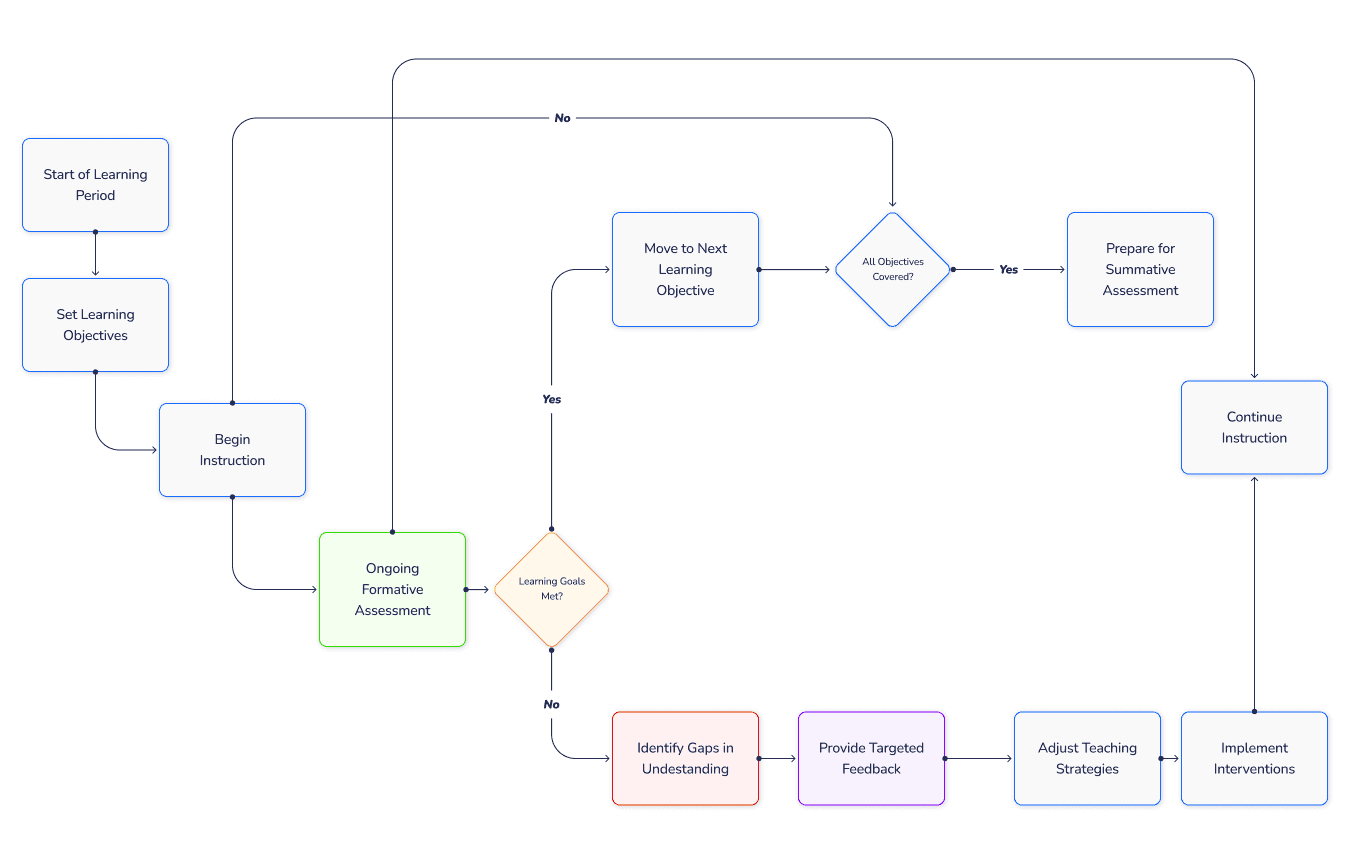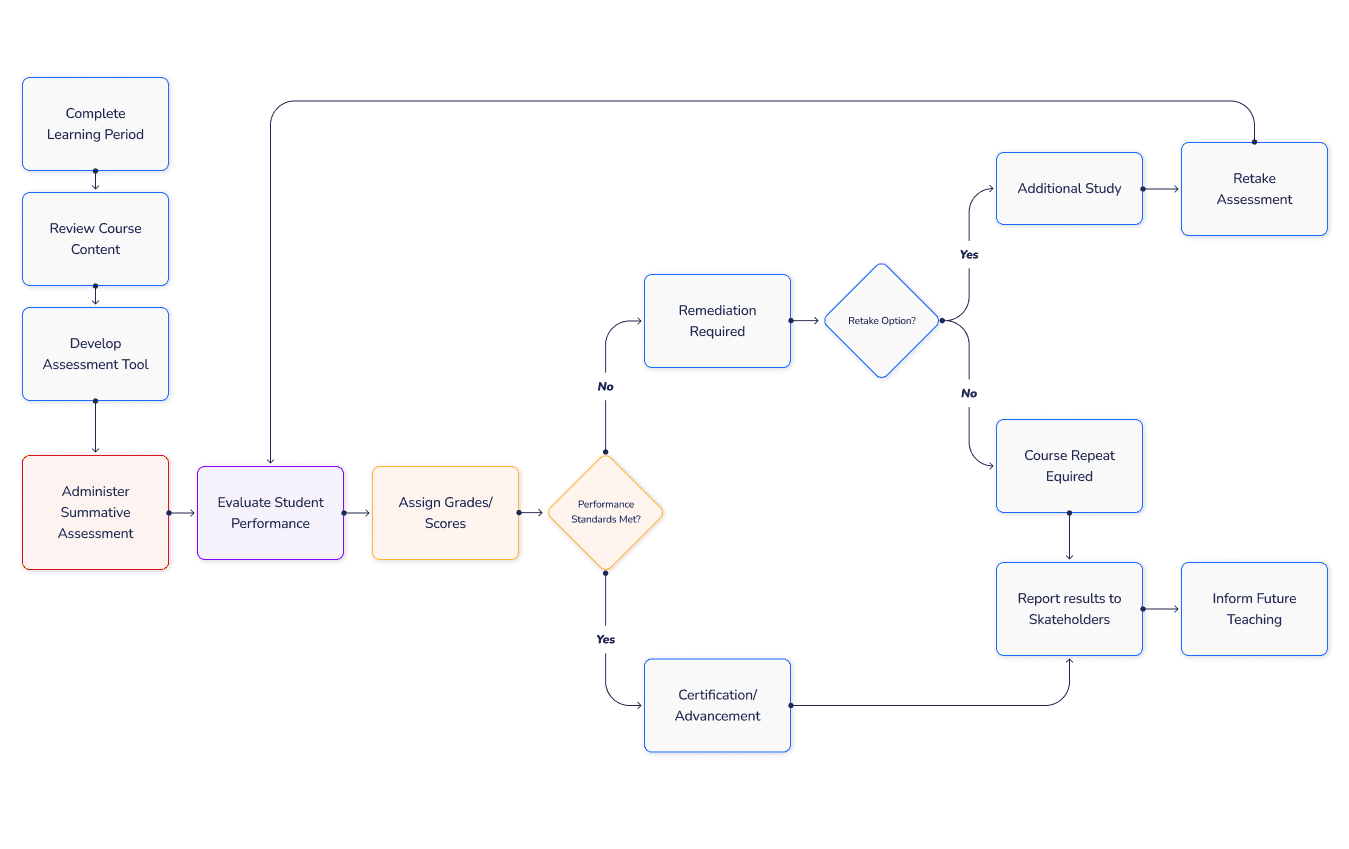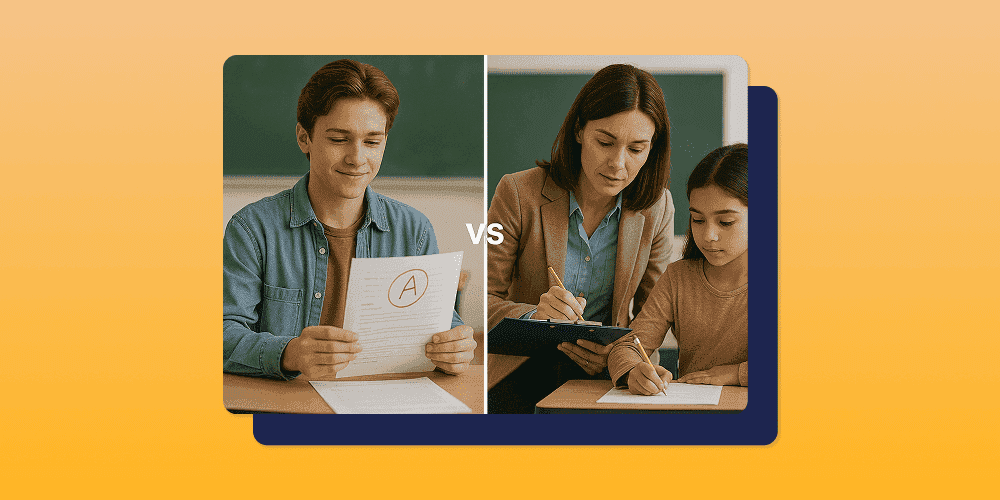
American summer tour! Wooclap will be at InstructureCon 2025
Come say hi at booth 41 from July 22nd to July 24th in Spokane, Washington
Formative Assessment VS Informative Assessment: The Impact on Learning Outcomes in Education
26.05.2025 • 5 minutes

A recent study by Redilat found that students who constantly learn with formative assessments improve their grades by an average of 12%, compared to a 6% increase when they mostly use other forms of traditional assessments.
For the longest time, traditional assessment methods have focused heavily on standardized tests that measure a student’s cumulative knowledge, rather than on the quality of their overall learning experience. As a result, students focus more on passing than on understanding and retaining the content of the learning materials.
Formative assessments remain one of the most powerful tools educators and learning instructors can use to shape the learning journey.
On the other hand, informative assessments don’t exist–it isn’t a standard industry term that’s used in educational research. Instead, the opposite of formative assessments is summative assessments.
In this article, we’ll do a deep dive into the differences between formative and informative assessments. We’ll also:
- Explore the impacts formative and summative assessments have on student learning outcomes,
- Shed more light on how informative assessments is not a standard industry term,
- And discuss the importance of formative assessments to the success of modern educational systems and student progress.
What is Formative Assessment?
Formative assessments is an evaluative technique that informs both students and teachers about the progress made towards learning goals.
These assessments are not only frequent, but they’re also low-stake so that students can feel comfortable being honest about their understanding. As a teacher, these assessments can help you collate student data and ongoing feedback throughout the learning process, reduce the pressure your students feel to perform, and lower the incentives they have to try and cheat.
This qualitative feedback loop is the reason why formative assessments are called “assessments for learning”. When administering formative assessments, educators often use interactive elements that make learning fun, engaging, and memorable.

Some examples of common formative assessments include:
- Live Classroom Polls: The teacher asks multiple-choice questions and polls to measure student understanding levels.
- Interactive Quizzes: During a lesson, students write a quick response to a quiz to check their level of understanding about a concept.
- Think-Pair-Share: Also referred to as turn and talk, it's a method where students discuss a topic with a partner before they share their answers with the class.
- Self-Assessment Checklists: Students rate their own understanding of a topic using a checklist before they move on to another topic.
- Concept Maps: Students create diagrams and visually link key ideas to demonstrate how well they understand a topic
- Exit Tickets: Students provide short, evaluative feedback to open questions before they leave the class to help the teacher plan for the next lesson.
- One-Minute Papers: Students provide brief written responses to non-graded prompts like 'What was the most important thing you learned today?'
- Digital Response Systems: Teachers allow students to use supportive apps when answering questions in real-time so that the teacher can access immediate data on comprehension levels.
Clearing Up the "Informative Assessment" Misconception
There's a common misconception that leads people to search for "informative assessment" as the opposite of formative assessment. This is understandable given the terminology, but it's important to clarify:
"Informative assessment" is not a legitimate term used in educational practice or literature.
The correct counterpart to formative assessment is summative assessment.
This misconception likely stems from confusion about the terminology. While formative assessments do provide information (they are informative in nature), the established educational term for end-of-learning evaluations is "summative assessment."
Understanding Summative Assessment
Unlike formative assessments, summative assessments happen at the end of a learning period and are used to test and record a student's cumulative knowledge. Some popular examples include final grade exams or national standardized tests like the SAT and GMAT.
These assessments are often high-stakes for students because they influence their final grades, graduation chances, and even future education opportunities.

Some common examples of summative assessments include:
- Standardized Tests: The teacher tests the whole class to assess performance. These scores have no immediate effect on current teaching strategies and methods.
- Report Cards: These cards provide a summary of the student's performance for the term but do not provide any guidance on how they can improve their performance.
- Course Evaluations: Students can rate the course at the end of the term, but this feedback is used for future improvements, not to make immediate learning adjustments.
- Graduation Rates: The learning institution tracks how many students graduate, but this figure doesn't directly impact any individual's learning process.
- National or International Benchmark Assessments: State tests that compare an individual student's performance against large groups but don't influence daily classroom teaching.
The Impact of Formative and Summative Assessments on Learning Outcomes
Both approaches serve distinct but complementary roles in the learning process. If you’re an educator, understanding how they interact and affect learning will help you create more effective educational environments.
Assessment Types Compared
Formative Assessment | |||||
| Primary Purpose | Timing | Stakes | Feedback | Examples | Focus |
Monitor learning progress and improve teaching/learning | End of instructional period | Low-stakes, often ungraded | Detailed, specific, actionable | Quizzes, discussions, drafts, peer reviews | Process-oriented ("assessment FOR learning") |
Summative Assessment | |||||
| Primary Purpose | End of instructional period | Stakes | Feedback | Examples | Focus |
Evaluate and document student achievement | Ongoing process throughout instruction | High-stakes, typically graded | Limited, often score-based | Final exams, term papers, standardized tests | Outcome-oriented ("assessment OF learning") |
Impacts of Formative Assessment
1. Enhanced Critical Thinking and Problem-Solving: Formative assessment strategies push students beyond memorization toward deeper analytical skills. Methods like Think-Pair-Share and Socratic questioning encourage them to evaluate ideas, defend reasoning, and refine understanding.
The Education Endowment Foundation's Eppi Centre (2018) found that when students engage in self-assessment and peer discussions, they develop stronger problem-solving and analytical skills. (eppi.ioe.ac.uk) This form of collaborative assessment builds metacognition and critical thinking.
2. Improved Academic Performance Through Active Engagement: Regular low-stakes assessments significantly boost retention and comprehension by creating a rhythm of engagement with course material.
A meta-analysis by Credé & Sotola (2020) covering 52 college classes (nearly 8,000 students) found that implementing weekly low-stakes quizzes markedly improved student outcomes. Students with at least weekly quizzes performed significantly better on midterm and final exams than those in courses with only a midterm/final format. (news.las.iastate.edu)
The researchers noted that the odds of passing "went through the roof" in classes using regular quizzes, with particularly strong benefits for initially struggling students.
3. Better Long-Term Retention: Multiple studies confirm that the "testing effect" strengthens memory. When students repeatedly recall information through periodic formative assessments, they significantly improve long-term retention compared to cramming for a single test.
An OECD report (2005) concluded that formative assessment "improves the retention of learning" and elevates work quality, with particularly strong benefits for underachieving students. (frontiersin.org)
4. Increased Motivation and Self-Regulation: Continuous, constructive feedback promotes student engagement and ownership of learning.
A systematic review by Black & Wiliam (2018) found that students receiving continuous, constructive feedback are more likely to be engaged and take ownership of their learning progress. Understanding strengths and growth areas develops a growth mindset that increases persistence and effort. (frontiersin.org)
Hattie's meta-analysis placed teachers' use of formative evaluation near the top of 138 factors influencing achievement, with an effect size around 0.90 (very high impact).
Impacts of Summative Assessment
1. Accountability and Standards Alignment: Summative assessments help ensure educational institutions and programs meet established standards.
Research by Darling-Hammond & Adamson (2022) demonstrates that well-designed summative assessments can evaluate whether the curriculum objectives align with broader educational goals and standards. (eppi.ioe.ac.uk)
2. Program Evaluation and Improvement: Beyond individual assessment, summative data provides valuable insights at the program level.
Research by Herman & Baker (2021) shows that summative assessment results help administrators evaluate educational program effectiveness, identify systemic issues, and make data-driven decisions about resource allocation. (files.eric.ed.gov)
3. Student Motivation Through Milestones: When properly framed, summative assessments can motivate and focus student effort.
A study in the Journal of Educational Psychology (Wilson, 2019) found that preparing for summative assessments can increase student engagement when properly framed as opportunities to demonstrate mastery rather than threats.
However, research also shows that heavy use of summative tests can push students toward performance goals (aiming for scores) instead of mastery goals (deep understanding). (eppi.ioe.ac.uk)
Practical Applications of Formative vs Summative Assessments in the Classroom
Whether you’re a school administrator, educational policymaker, or a teacher,there are many practical ways to combine the benefits of formative and summative assessments. In this section, we provide a few examples of research-backed formative and summative strategies that you can use to create a responsive and interesting learning environment for your students.
Formative Assessments
- Frequent Low-Stakes Quizzes: As a teacher, you can include weekly quizzes that cover key concepts into your lesson plan. These short, multiple-choice, or open-ended reflections focus on reinforcing learning without adding pressure on your students. Studies show that frequent low-stake quizzes also strengthen memory recall and allow instructors to identify knowledge gaps early
- Think-Pair-Share Activities: During complex topics, you can ask students to think independently about a question, discuss their thoughts with a peer, and then share their answers with the class. Collaborative learning strategies like Think-Pair-Share can encourage peer discussions that enhance critical thinking and comprehension.
- Exit Tickets: As part of your teaching process, you can ask your students to summarize their key takeaways at the end of a lesson. A recent study from the Eppi Centre (2020) suggests that exit tickets promote self-regulation and improve long-term retention. This mini-exercise provides you with real-time insights into their comprehension level, making it easier for you to clarify misunderstandings and optimize the next lesson for success.
Summative Assessments
- Two-Stage Exams: Research shows that two-stage exams reduce test anxiety and reinforce learning through peer discussion. To implement this model, you’ll first require that your students complete a non-graded, individual test. Immediately after that, they retake key portions of the test in small groups. Two-stage exams particularly help students who struggle with comprehension and retention because it encourages them to listen to multiple perspectives.
- Pre-Assessment Review Strategies: Before any graded test or exam, you can run practice quizzes, self-explanation exercises, and flash card sessions. These pre-test exercises help students prepare much better for exams and improve their retention capacity. According to a study by Agarwal et al. (2021), there's a 30% higher retention rate in students who engage in retrieval-based review compared to students who study passively (just reading their books).
- Post-Assessment Reflection: One important, but often overlooked part of summative assessments is post-assessments reflection. After students receive their grades, you can encourage them to analyze their performance, go over concepts they didn’t understand, and set goals for future learning. Research has shown that students who reflect after their exams show significant growth in future assessments.
If you’re interested in trying some of these methods, Wooclap is a free tool that can help make your lectures more engaging and interactive. Try it here.
Conclusion: Finding the Right Assessment Balance
The term "informative assessment" is often incorrectly assumed to be the counterpart to formative assessment. This term doesn't actually exist in educational practice or literature and is conflated with summative assessment.
The evidence is clear: both formative and summative assessments play vital roles in modern education, but they serve fundamentally different purposes.
While summative assessments provide important benchmarks and accountability, formative assessments drive the ongoing learning process, leading to significantly better outcomes when implemented effectively — supported by the 12% grade improvement found in Redilat's research.
The most successful educational approaches integrate both assessment types strategically.
Formative assessments create frequent, low-pressure opportunities for students to practice, receive feedback, and develop critical thinking skills, while summative assessments allow lecturers to validate students’ knowledge and provide credentials for future opportunities.
Writer

The Wooclap team
Make learning awesome & effective
A monthly summary of our product updates and our latest published content, directly in your inbox.



